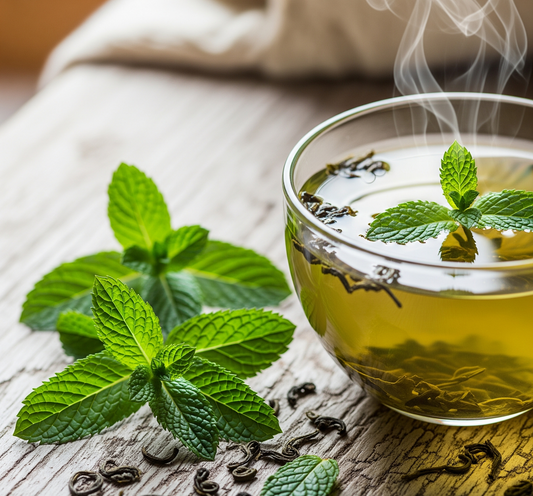Connoisseurs and enthusiasts of tea are often on the search for unique and exciting flavors of true tea that engage the senses. Among the brilliant flavors that can be crafted from the single tea plant: Camellia Sinensis, muscatel flavors stand out for their sweet wine-like flavor notes.
What is Muscatel Flavor?
Quick Answer: Muscatel notes are usually associated with fine wines created from muscat grapes.
Muscat grapes, which grow into a variety of shades, from pale white, yellow and pink to deep red and black shades, are used to brew some of the finest wines in the world First thriving in the Mediterranean region, muscat grapes have now evolved into diverse varieties and cultivars. Though such a range of muscat grapes exist, they all share the same captivating spicy and honey-like aroma, prized in fine wines.
The origins of Muscatel tea, however, doesn't come from muscat grapes. Though fascinatingly similar in taste and aroma, muscatel notes in tea arise completely free of muscat grapes. In this blog, we'll explore how muscat notes arise in tea leaves and why they are so sought after.
Introduction to Muscatel Flavors in True Teas:
Muscat notes in tea are generally elusive. They were first discovered during the second flush summer harvests of Darjeeling tea. Teas harvested from Nepal's high-altitude farms during the second flush also have distinct muscatel notes, such as our KTE Muscatel Reserve and our White Prakash white tea, an atypical white tea that is also sometimes referred to as silvery oolong.
 True teas, which are loose-leaf teas cultivated from the plant Camellia Sinensis, are crafted without the addition of any other flavorings from fruits, flowers, herbs or spices. The flavors true teas exude arise from characteristics inherent to the varietal and cultivar of the plant, along with the landscape in which it was grown, the climate, the season during which the leaves were plucked, and the manner in which the leaves were processed.
True teas, which are loose-leaf teas cultivated from the plant Camellia Sinensis, are crafted without the addition of any other flavorings from fruits, flowers, herbs or spices. The flavors true teas exude arise from characteristics inherent to the varietal and cultivar of the plant, along with the landscape in which it was grown, the climate, the season during which the leaves were plucked, and the manner in which the leaves were processed.
Read more: Nepal's Rare Climate and Rare Teas
What Tea Has a Muscatel Flavor?
Many tea lovers wonder, which tea has a muscatel flavor? The answer primarily lies in second flush Darjeeling tea and select Nepali second flush black teas. These teas, when harvested at the peak of summer, exhibit the distinct sweet and musky notes that closely resemble fine muscat wines. The combination of unique terroir, selective plucking, and careful oxidation results in the development of these exotic flavors.
 This means that no muscat grapes are used in the production of teas with muscatel flavors and taste notes. So how then do these teas have the spicy, honeyed grape aroma congruent with fine muscat wines?
This means that no muscat grapes are used in the production of teas with muscatel flavors and taste notes. So how then do these teas have the spicy, honeyed grape aroma congruent with fine muscat wines?
Fine Muscatel Tea
Fascinating Muscatel flavors from Intriguing Ecosystems
It is surprising for most people to learn that the sweet, delicate and luxurious muscatel flavors in tea actually comes from an environmental interaction of tea leaves with small insects, jassids and thrips. As the heat rises during the summer months, these sap-feeding insects rise in number in the high-altitude tea gardens of South Asia.
As the insects nibble on the young tea leaves, they cause damage to the tender leaves. In defense, the tea leaves produce an insect-repelling compound, terpene. While terpene is toxic to the insects, it is harmless to consume by humans, and when the leaves with high concentrations of terpene are mildly oxidized, it produces a grape-like, aromatic muscat flavor in the tea.
What Makes Muscatel Tea Special?
Distinctive Aroma & Flavor: Unlike regular black teas, muscatel teas have a sweet, honey-like, and wine-like musky aroma.
Naturally Occurring Process: No additives or artificial flavoring are used; the taste is completely natural.
Limited Availability: Found only in specific second flush Darjeeling and Nepali black teas, making it a prized choice for connoisseurs.
Unique Brewing Experience: The complex flavors develop best when brewed at the right temperature and steeped properly.
 This is also an interesting reason why our white tea, White Prakash, contains muscatel flavors. While other White Teas go through minimal processing, White Prakash, harvested during the second flush, go through a gentle rolling process that allows them to gently ferment. This process highlights the sweet, spicy and musky notes that are reminiscent of muscat grapes in wine.
This is also an interesting reason why our white tea, White Prakash, contains muscatel flavors. While other White Teas go through minimal processing, White Prakash, harvested during the second flush, go through a gentle rolling process that allows them to gently ferment. This process highlights the sweet, spicy and musky notes that are reminiscent of muscat grapes in wine.
Conclusion: Wine-Like and Elegant
Though muscat wines and teas with muscatel flavor notes are created through different processes, the sensorial enjoyment of both the wine and the tea are alike. The heady grape flavors found in muscatel tea mirrors the tasting experience of savoring fine muscatel wines.
Just as wine enthusiasts appreciate the layers of taste in a well-aged vintage, tea lovers relish the multifaceted profile of muscatel tea, with delicate floral undertones and smooth, round impressions. Muscatel flavors create a bridge between the worlds of tea and wine, inviting enthusiasts to explore the complexity of both beverages.
Frequently Asked Questions (FAQs) about Muscatel Teas
What is Muscatel Tea?
Muscatel tea is a rare and highly prized black tea known for its sweet, musky, and wine-like notes, reminiscent of muscat grapes. It is primarily found in second flush Darjeeling teas and select Nepali high-altitude teas.
Which Tea Has a Muscat Flavor?
Tea lovers looking for muscat flavors should try second flush Darjeeling black tea and Nepali second flush black teas, particularly those grown at high altitudes.
How is Muscatel Flavor Formed in Tea?
The muscatel flavor in tea is a result of tea leaves interacting with sap-sucking insects like jassids and thrips. The leaves produce a defensive compound, terpene, which enhances the tea’s flavor during oxidation.
Is Muscatel Tea Naturally Flavored?
Yes, muscatel tea is 100% natural and does not contain any added flavors. The grape-like aroma and sweet musky notes develop naturally due to the unique terroir and insect interaction.
About the Author
Nishchal Banskota is the founder of Nepal Tea Collective, dedicated to offering the finest Nepali teas. With years of experience in the tea industry, Nishchal is passionate about sharing the culture and craftsmanship of Nepali tea with the global tea industry. Learn more about Nepal Tea Collective and explore a variety of award-winning teas that bring you closer to the heart of Nepal.




